Electric snow blowers:
An electric snow blower, as shown in Figure 3, is often called an electric shovel. It is designed to automate the manual task of using a snow shovel. It does not have the power or features that are found in gas powered snow blowers. Whereas gas snow blowers are rated in horsepower, an electric snow blower is generally rated in amps and will draw between 7 and 12. The auger style is single-stage having the same mechanical features as a single-stage gas snow blower. The larger electric snow blowers will clear 21 inches and can deliver snow approximately 30 feet.
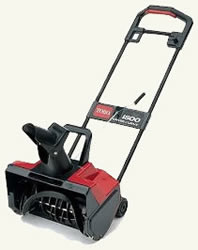
Figure 3 - Electric snow blower
Relative to gas powered snow blowers, electric snow blowers are less costly, much lighter in weight making them easier to handle and store. As they are powered by electricity, they must be plugged in at all times, making their use subject to the availability of AC power, while on the other hand there is no need for gas cans and oil.
In geographic areas where it does not snow often, and when it does it is relatively light, the electric snow blower is ideal for small properties in order to clear snow from balconies, and porches.
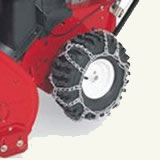
Figure 4 - Snow blower chains
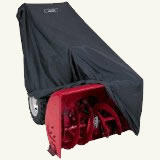
Figure 5 - Snow blower cover
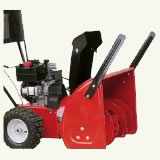
Figure 6 - Snow blower drift cutter
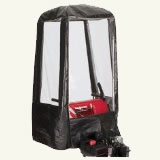
Figure 7 - Snow blower cab
Snow Blower Features & Accessories:
There are generic snow blower accessories as well as accessories made by the manufacturer of the snow blower. The following list represents the most popular accessories available. Not all accessories are available for all snow blowers.
Cabs:
Cabs, as shown in Figure 7, protect the operator from the backlash of winter winds and from discharged snow blowing backwards. They allow operators to work for longer periods of time in inclement weather conditions.
Drift Cutters:
Drift cutters are bars of steel that are mounted on the sides of the front auger housing, as shown in Figure 6. The drift cutters cut through high banked snow causing the snow to fall in front of the auger housing rather than on top of the snow blower as it passes.
Headlights:
Clearing snow in the winter can involve working at night and having headlights mounted on the snow blower so that you can see where you are operating can make the job a lot easier and much safer. Headlights not only provide you with much needed light, but increase your visibility to traffic.
Heated Handlebars:
Heated handlebars allow the snow blower operator to operate for longer periods of time by keeping the operator’s hands warm while working.
Machine Covers:
A snow blower is an expensive investment and needs to be protected from the elements. If you do not have a garage or a shed you should consider purchasing a snow blower cover as shown in Figure 5, to provide protection from the elements.
Power Steering:
Power steering on a snow blower is not what one finds on their car. Snow blower powering steering is the ability to disengage one wheel from the power train, allowing only the other wheel to turn. This is the manner that one turns a tracked machine such as a bulldozer. It allows the machine to basically turn in a very short radius and aids in the snow blower’s maneuverability.
Tire Chains:
Chains, as shown in Figure 4, provide the wheels with much more traction or grip and are very beneficial when working on grades and surfaces that have underlying ice.
Tire Size & Tread:
Although usually not an option, consideration should be given to the size of the tires on the snow blower you are considering purchasing. Tire sizes vary from 5 to 16 inches. As a general statement the larger the tires the better the grip and traction. The better the tread the better the traction. Most snow blower tires are filled with air and it is important to check air pressures often as working in extreme cold can cause tires to deflate.
Selection of snow blowers.
